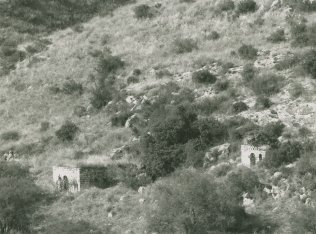The village stood on a hill that overlooked the deep gorge of Wadi al-'Amud, to the northeast of Lake Tiberias. Some of its houses, also, were built on the edge of the wadi, opposite the hill. A number of trails along the wadis linked it to the neighboring villages and khirbas, and a road (constructed after 1947) connected it to highways leading to Safad, Tiberias, and Acre. The Bedouin of the 'Arab al-Sayyad and al-Qudayrat tribes pitched their tents near the eastern edge of the village. AI-Shuna's houses were made of mud and stone and formed a nearly circular pattern. Because the rough bluffs west and southeast of the village hemmed it in from those directions, new housing was built towards the west. Its population was predominantly Muslim. It had a few shops, a mosque, and a school. The villagers dug wells at the foot of the hills on the west side to collect rain water for drinking. In 1944/45 they planted a total of 995 dunums in cereals. Khirbat al-Shuna, nearby, contained the ruins of a former village, the houses of which were built of basalt; to the south of it lay Khirbat Sirin.

